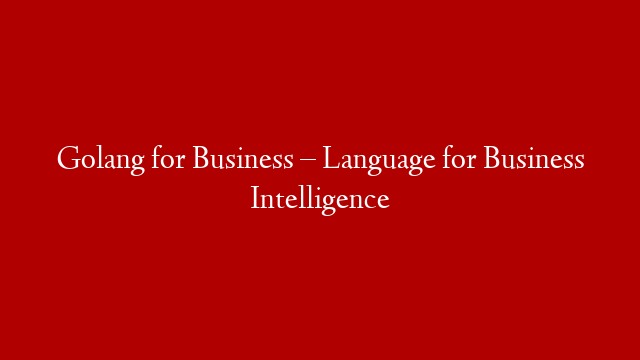Golang for Business
With a plethora of programming technologies used today, Google’s Golang for business sets out to be trendy, popular and interesting as described by majority of companies using Golang or Software Developers today. But a question still remains, “Is Golang/Go really an eligible contender having applicability for various software development practices for various platforms and solutions?” Let’s answer this question with some facts about Golang.
History of Go Programming Language
Go was introduced by Google in 2007 by Robert Griesemer, Rob Pike, and Ken Thompson. Whereas it was announced in 2009 and Go 1.0 was released in March 2012. Go is already in use at Google and other farms since November 2009 and the compiler for Golang “gc”, is developed as an open source software and targets various platforms, including Linux, OS X, Windows, various BSD and Unix versions, and also mobile devices, including smartphones. Leading companies using Golang such as Cloudflare, Sendgrid, Dropbox, Soundcloud, Bitly, Digitalocean, Stathat and many more started using GoLang, replacing their existing technologies.
Features of Golang
The Golang is loaded with advanced technology features. Go was born out of frustration with existing languages and environments for systems programming. Programming had become too difficult and the choice of languages was partly to blame. One had to choose either efficient compilation, efficient execution, or ease of programming; all three were not available in the same mainstream language. Programmers often chose ease over safety and efficiency by moving to dynamically typed languages such as Python and JavaScript rather than C++ or, to a lesser extent, Java.
Again, we don’t want to discuss about technical features about Golang, since many experts have repeatedly proved Golang’s superiority on multiple forums. Golang business and organization architecture, your Enterprise Resource Planning (ERP) systems, form the critical operational component to optimize with latest development in technology solutions. Internet of Things, Connected Enterprise, Field Mobility, Cloud as a Backend, scalable infrastructure are some of the technology focus areas which promises accelerated business growth. Golang can help delivery scalable architecture helping you manage complex server system for maximum throughput. Let’s do a deep dive into GoLang’s applicability to growing industry.
Golang for Business
“Go will be the server language of the future.” says Tobias Lütke, Shopify
Let’s start with Customer Relationship Management (CRM) systems, Golang for business entities practice, strategize, manage and analyze customer interactions and data throughout the customer lifecycle, with the goal of improving Golang for business relationships with customers, assisting in customer retention and driving sales growth. CRM software consolidates customer information and documents into a single CRM database so business users can identify high probability customer conversions effectively. Many vendors have already started implementing CRM using Golang replacing existing technologies like Python. Golang has potential to implement real time access of voluminous customer data (also known as the Big data ) at half the efforts required.
Go and Docker Technology
In the next iteration, Mobile development will be an added feature in Golang with its upcoming advanced libraries beating existing mobile application development platforms. Docker is yet another trendy tool for packaging and running applications in lightweight containers. Docker makes it easy to isolate, package, and deploy applications, and is beloved by system administrators. Its creator Solomon Hykes cited Go’s standard library, concurrency primitives, and ease of deployment as key factors, and said “To put it simply, if Docker had not been written in Go, it would not have been as successful.”
Golang packs in a lot of potential to become the future in the Technology world capable of providing smart Golang for business solutions.



